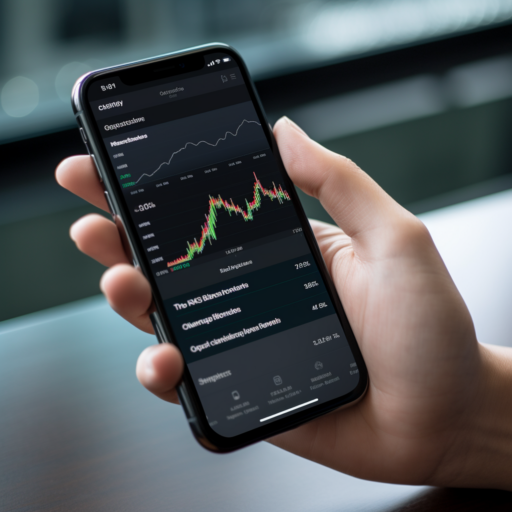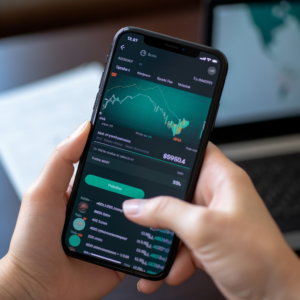Income ETFs, like all other income-generating investment strategies, require some degree of moderation.
Stocks that offer significant yields might be appealing due to the prospect of “guaranteed” payouts that are two, three, or even five times higher than the S&P 500.
This holds particularly true in the context of heightened market volatility, as shown in the past few years.
However, it is a fact that there are no assurances or certainties when it comes to investing in the financial markets.

Amid the current high interest-rate environment, investors who previously had no other options outside stocks during a long period of low-interest rates are now shifting their investments back to bonds.
Furthermore, it is worth noting the fact that the current yield of the S&P 500 is slightly under 1.6%.
Nevertheless, it is crucial to bear in mind that over an extended period, the stock market consistently exhibits an upward trajectory.
For long-term investors that prioritize long time horizons, the best-performing income ETFs have considerable benefits as they provide both possible capital appreciation and a moderate income source.
Undoubtedly, the level of risk associated with U.S. government bonds is lower. However, it is important to note that there is also a far higher potential for gain.
However, it is crucial to thoroughly examine these top-performing income funds and assess their compatibility with your entire investment portfolio and your individual risk tolerance.
If you want to invest as an expat or high-net-worth individual, which is what i specialize in, you can email me (advice@adamfayed.com) or use WhatsApp (+44-7393-450-837).
Table of Contents
What are Income ETFs?
As opposed to investing for capital appreciation, high-yield ETFs or income ETFs aim to provide investors with a steady stream of income, usually on a monthly or quarterly basis.
These funds can take several forms, including mutual funds and ETFs. These pools of capital often hold a wide variety of best income-generating assets, including preferred shares, money market instruments, top income-generating securities, and obligations issued by corporations, municipalities, and the federal government.
The share price of an income fund might go up when interest rates go down and down when interest rates go up. In most cases, these funds only invest in bonds that have excellent credit ratings.
There is no security for the invested capital that does not have a sufficient level of creditworthiness.
The high-yield bond fund and the bank loan fund are two common types of high-risk investment vehicles that aim to generate revenue by the purchase of corporate garbage bonds and floating-rate loans from various financial institutions, respectively.
Many different kinds of income funds exist. The key difference is in the assets that are used to generate income.
11 Best Income ETFs
Global X U.S. Preferred ETF (PFFD)
Preferred shares are a compelling ‘hybrid strategy’ that exhibits characteristics of both debt and stocks. If you are seeking an asset class that generates income and falls between the risk levels of bonds and equities, it may be of interest to you.
To have access to preferred shares, it is advisable to consider investing in PFFD.
Selecting specific preferred share offerings can be challenging, as each one is accompanied by distinct terms and dividend payments.
Investors who purchase PFFD can obtain a significantly diverse collection of 212 securities with an expense ratio of 0.23%.
A substantial portion of these securities are from companies in the financial industry. PFFD currently has a 6.9% yield for the past 12 months, and it distributes payments on a monthly basis.
Building a diversified investment strategy is crucial, and incorporating the best income ETFs alongside the best financial ETFs can enhance your portfolio by providing a balanced approach to generating income and capital growth.
Schwab U.S. Dividend Equity ETF (SCHD)
An ideal starting point for investors seeking the best dividend ETFs for long-term investors would be the Schwab U.S. Dividend Equity ETF (SCHD, $73.52).
This fund is among the largest in terms of assets among all income-focused investment options available on Wall Street.
Its significant size, combined with its straightforward design, makes it one of the most cost-effective choices, with a very low fee structure that will only amount to a few dollars per year for the majority of investors.
The approach is quite direct: SCHD is evaluated against the Dow Jones U.S. Dividend 100 Index. Therefore, this fund contains a portfolio of 100 very prominent and easily tradable stocks that offer dividends higher than the average.
In order to be eligible, corporations must have consistently distributed dividends for a minimum of 10 consecutive years.
The outcome enables you to increase the present yield of the S&P 500 by two-fold while remaining invested in well-known, low-risk companies that are easily comprehensible.
Currently, the main assets in this dividend ETF include the pharmaceutical company Merck (MRK), the technology corporation Cisco Systems (CSCO), and the home improvement retailer Home Depot (HD), among others.
These kinds of equities, known as “risk-off” stocks, tend to do well during times of market volatility. Additionally, this high-dividend ETF is expected to be beneficial for investors in the upcoming year.
Global X Nasdaq 100 Covered Call ETF (QYLD)
Covered call ETFs allocate their passive income investments over a range of stocks and engage in the practice of selling call options on the underlying individual firms or indices.
The outcome is a consistent flow of revenue generated by the proceeds obtained from the sale of call options.
These ETFs essentially convert the potential for gains from their underlying investment into an immediate cash payment.
QYLD is a highly sought-after ETF that specializes in selling covered calls on the Nasdaq-100 index. QYLD is capable of generating substantial premiums due to the Nasdaq-100’s significant volatility, resulting in a 12.6% trailing yield over a 12-month period.
This ETF has consistently provided monthly payouts for a continuous period of nine years. Nevertheless, it has a rather elevated expenditure ratio of 0.6%.
Building a wealth-generating portfolio involves strategically selecting the best income ETFs and consumer discretionary ETFs, harnessing the combined power of steady returns and growth potential.
SPDR Portfolio S&P 500 High Dividend ETF (SPYD)
The SPDR Portfolio S&P 500 High Dividend ETF (SPYD, $36.59) achieves a higher yield by making slight adjustments while maintaining the same components.
This fund, as indicated by its name, initially comprises the S&P 500 Index, which consists of the greatest American firms.
Subsequently, it focuses specifically on the top 15% of stocks with the highest dividend yields. This results in a portfolio consisting of approximately 80 firms and a yield that surpasses that of the majority of other large-cap index funds.

Not unexpectedly, this also results in a substantial shift in the industry’s focus compared to other diversified income ETFs.
More precisely, financial stocks make up the largest portion of the portfolio, accounting for 23%. This is achieved through investments in companies such as Principal Financial Group (PFG).
Subsequently, there is an allocation of 20% towards real estate stocks and 15% towards utility companies.
These particular Big Tech companies do not exhibit the same level of growth as the ones that dominate dividend-focused ETFs.
Alternatively, if your primary focus is on generating income rather than capital gains, SPYD presents an excellent opportunity for investors in search of income-generating funds.
This ETF allows users to invest in large-cap firms that offer substantial dividend payouts.
JPMorgan Equity Premium Income ETF (JEPI)
JEPI is another widely sought-after covered call ETF worth monitoring. Since its inception in May 2020, this ETF has accumulated around $30 billion in assets under management (AUM).
JEPI does not engage in the sale of covered calls on an index, in contrast to QYLD. Instead, the ETF initiates by actively choosing a collection of companies specifically tailored to generate the majority of the S&P 500 index’s profits while minimizing fluctuations in value.
Subsequently, the ETF employs a covered call technique in order to produce substantial monthly revenue. However, JEPI does not directly offer index call options for sale, unlike QYLD.
JEPI, in order to get its covered call exposure, utilizes equity-linked notes (ELNs) with a counterparty since it does not possess all of the constituent S&P 500 index equities. JEPI has a fee of 0.35% and offers a 12-month return of 9.1%.
Global X SuperDividend ETF (SDIV)
Naturally, the concept of “big dividends” is subjective and dependent on individual perspectives. Examining the Global X SuperDividend ETF (SDIV, $21.69) will demonstrate the presence of lucrative prospects within the top dividend growth ETFs, characterized by a yield that is remarkably impressive.
This assertive Global X offering actively seeks to achieve high returns, prioritizing yield above all other considerations, regardless of its source.
This includes smaller multinational companies such as Dana Gas, a utility company based in the United Arab Emirates, and Shanghai Industrial Holdings, an industrial stock from China.
Additionally, it encompasses less familiar U.S. companies such as real estate investment trusts (REITs), Ready Capital (RC), and Arbor Realty Trust (ABR).
This carefully curated selection of approximately 100 companies undoubtedly carries a greater level of risk compared to a conventional fund.
Nevertheless, this fund offers an unparalleled income stream, surpassing even the most exceptional yield-focused exchange-traded funds available.
If you possess a significant inclination towards taking risks or prioritize receiving rewards above all other factors, then it may be worthwhile to consider examining SDIV.
Indeed, several dividends from emerging market corporations exhibit irregularity, deviating from a predictable quarterly pattern.
Indeed, certain corporations are currently distributing dividends that they may perhaps lack the financial capacity to sustain in the coming years. However, the yield is indisputable.
Diversify your investment portfolio by strategically combining the stability of the best consumer staples ETFs with the income-generating potential of the best income ETFs, creating a well-rounded approach to financial growth.
Alerian MLP ETF (AMLP)
Investors seeking a lucrative investment with the ability to protect against inflation may want to explore master limited partnerships, also known as MLPs.
These businesses typically engage in energy infrastructure activities, with a specific focus on the transportation, storage, and processing of natural resources such as oil, natural gas, and refined products.
This enables them to create consistent and predictable cash flows.
If you want to gain exposure to a diverse range of MLPs, you should consider investing in AMLP, an exchange-traded fund that closely follows the performance of the Alerian MLP Infrastructure Index.
This Exchange-Traded Fund (ETF) has accumulated more than $7.2 billion in Assets Under Management (AUM) and has offered a respectable 7.8% yield over the past 12 months.
AMLP achieved a return of 34.5% and 25.1% in 2021 and 2022, respectively, amidst the increasing inflation. Nevertheless, the ETF imposes a somewhat steep expense ratio of 0.85%.
iShares International Select Dividend ETF (IDV)
The iShares International Select Dividend ETF (IDV, $25.76) offers a middle ground between the high but uncertain payouts of SDIV components and the consistent performance of large-cap U.S. equities.
Although these firms may not possess the same level of brand recognition as the top dividend stocks in the Dow, they are dominant players in their respective industries and highly esteemed in their native nations, with market values in the billions.
London-based mega-miner Rio Tinto Group (RIO), Japanese maritime leader Nippon Yusen (NPNYY), and Swiss financial icon Zurich Insurance Group (ZURVY) are part of IDV’s portfolio, which consists of approximately 100 stocks.
The countries with the highest levels of exposure, ranked in descending order, are the United Kingdom (14%), Canada (10%), and South Korea (9%).
Several foreign countries have developed a culture of regularly providing substantial dividends. This is because publicly traded corporations in countries such as the U.K. and Japan are actively seeking pension plan managers as investors.
Consequently, despite prioritizing the leadership of large-cap companies in this area, it is possible to frequently encounter profitable opportunities with returns of 5% or higher.
Currently, IDV provides a substantial payout that exceeds the dividend of the S&P 500 by more than fourfold.
Furthermore, a notable advantage is that if you already have significant holdings of U.S. stocks in other areas of your investment portfolio, you can seamlessly incorporate IDV without creating any redundant positions.
Global X SuperDividend REIT ETF (SRET)
U.S. real estate investment trusts, sometimes known as REITs, have a legal obligation to distribute 90% of their earnings to investors.
This requirement typically guarantees a more consistent and reliable flow of income. Nevertheless, the dividend yields of REITs can exhibit significant variations, and it is worth noting that not all REITs distribute dividends on a monthly basis.
In order to tackle this issue, Global X provides SRET, which monitors the 30 REITs with the highest dividend yields worldwide, as indicated by the Solactive Global SuperDividend REIT Index.
Presently, investors can anticipate a substantial 12-month trailing yield of 8.4% in addition to regular monthly payments, which the ETF has continuously disbursed for a consecutive period of eight years.
However, it is worth noting that the historical performance of this ETF has been unsatisfactory, with a negative annualized total return of -8.3% over the past five years. SRET has a fee of 0.59%, which is one basis point less than QYLD.
Alerian MLP ETF (AMLP)
When categorizing top dividend yield funds that pay dividends based on industry rather than location, it is evident that energy businesses are a logical starting point.
However, in contrast to more hazardous funds that invest in oil exploration and production firms, the Alerian MLP ETF (AMLP, $40.87) provides a less risky approach to investing in the sector, with a specific emphasis on “midstream” operations.
This dividend-focused exchange-traded fund (ETF) comprises approximately 15 energy corporations, primarily engaged in the pipeline and storage sectors.

This implies that they possess greater dependability and are better shielded from the fluctuations of oil prices, enabling them to provide more stable returns compared to other high-risk investments in the energy industry.
The current primary assets in the portfolio consist of Energy Transfer (ET), Plains All American Pipeline (PAA), and Magellan Midstream Partners (MMP).
The acronym MLP in the name of this high-yield ETF represents master limited partnerships.
As indicated by the final term used to describe this particular type of corporation, these high-income investment vehicles are organized as partnerships.
This structure allows them to distribute a significant portion of their operating income to unitholders, but it also entails additional responsibilities as partial owners of the organization.
Several investors like this requirement for dividends but detest the challenges and documentation that encompass the dreaded K-1 tax form annually.
Fortunately, AMLP provides information on a 1099 form for tax purposes and offers a varied and convenient method to enter the field, all while retaining the significant income that MLPs may provide.
iShares iBoxx $ High Yield Corporate Bond ETF (HYG)
Some of the best dividend-paying ETFs do not utilize equities or derivatives. Certain investments are classified as fixed-income.
HYG stands out because of its utilization of high-yield bonds, commonly referred to as junk bonds.
These bonds are issued by corporations that have credit ratings below investment grade, indicating a higher likelihood of default. In order to mitigate this risk, these bonds offer greater yields.
Investors can gain exposure to the high-yield bond market by purchasing HYG. This ETF replicates the Markit iBoxx USD Liquid High Yield Index, which specifically examines holdings for superior liquidity, an important factor for bonds since they are traded over the counter.
At present, investors can anticipate receiving monthly payments and a 6% yield over the past 12 months while incurring a 0.49% expense ratio.
Final Thoughts
Investors seeking optimal returns often turn to investment funds, with a focus on identifying the best income ETFs to maximize their financial portfolios.
The major goal is not always to maximize total profits for some investors. This is particularly true for those who are in the withdrawal phase of their investing journey.
They should instead be concentrating on making sure they have a steady stream of income coming in each month to fund their retirement. They should look into investing in ETFs for steady income.
Some investors are hesitant to sell their shares in order to accomplish this goal because they have a psychological bias against giving up the wealth they have worked so hard to achieve.
There are a number of ETFs that aim to provide above-average monthly income as a solution to this problem.
The ultimate objective of these ETFs is to provide a reliable source of income, and they achieve this through a wide range of investment methods and asset classes.
Pained by financial indecision? Want to invest with Adam?

Adam is an internationally recognised author on financial matters, with over 760.2 million answer views on Quora.com, a widely sold book on Amazon, and a contributor on Forbes.



